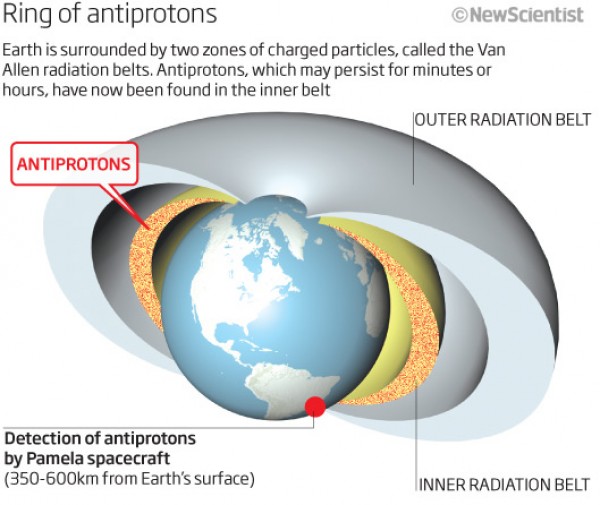Good news for the people responsible for fueling future spacecraft–a ring of antiprotons has been detected spiraling between the Van Allen belts. Theoretically, the antiparticle equivalent of protons could be used to power super-efficient rockets. “This is the most abundant source of antiprotons near the Earth,” says Alessandro Bruno, of the University of Bari in Italy. “Who knows, one day a spacecraft could launch then refuel in the inner radiation belt before travelling further.”
Charged particles called cosmic rays constantly rain in from space, creating a spray of new particles – including antiparticles – when they collide with particles in the atmosphere. Many of these become trapped inside the Van Allen radiation belts, two doughnut-shaped zones around the planet where charged particles spiral around the Earth’s magnetic field lines.
Heavier particles take wider paths around the planet’s magnetic lines, whereas lighter particles, like positrons (the antiparticle’s answer to electrons) make nice, regular spirals. We already knew there were positrons in the radiation belts, but at nearly 2000 times as massive and lacking evidence of any antiproton cloud hanging around the Earth, antiprotons were thought to be weighty enough to get pulled into the atmosphere, where they’d collide with normal matter and annihilate. But the cosmic-ray detector PAMELA has confirmed that the Van Allen belts work in a way similar to magnetic traps to hold antiprotons for minutes or even hours before they inevitably meet normal matter and cease to exit.
Between July 2006 and December 2008, PAMELA detected 28 antiprotons trapped in spiralling orbits around the magnetic field lines sprouting from the Earth’s south pole (Astrophysical Journal Letters, DOI: 10.1088/2041-8205/737/2/l29). PAMELA samples only a small part of the inner radiation belt, but antiprotons are probably trapped throughout it. “We are talking about of billions of particles,” says team member Francesco Cafagna from the University of Bari in Italy.
Twenty-eight antiprotons sounds like nothing, really. But that’s actually a pretty substantial quantity, and verifies the hypothesized but not-yet-evident theory that such a ring might exist. So it looks like now all we need are those super-efficient rockets, Science.
[source: 1|2] [image: New Scientist]

